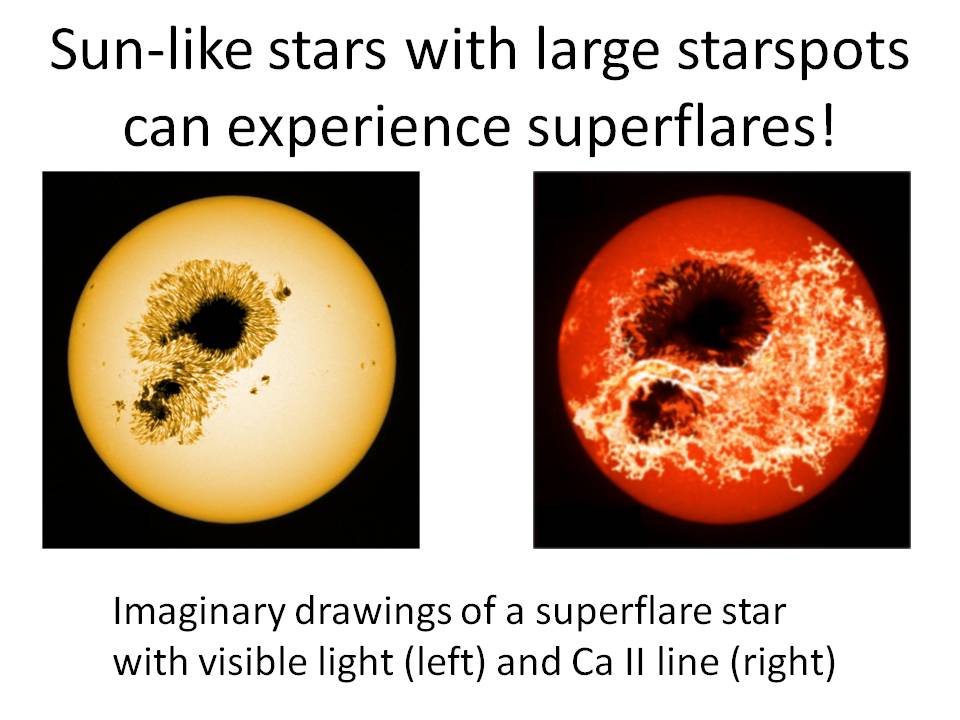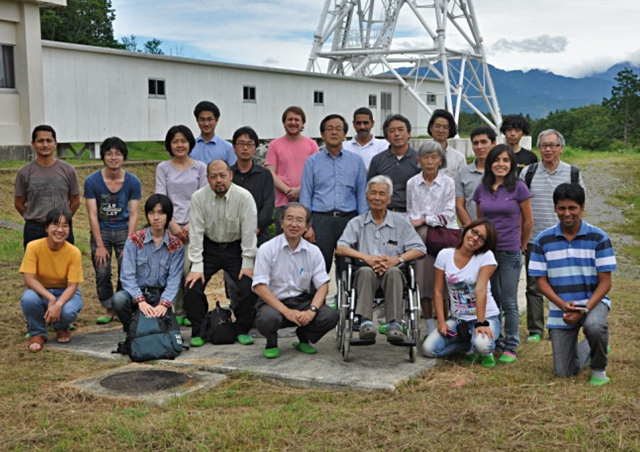|
Superflare
|
Probable detection of an eruptive filament from a superflare on a solar-type star.
NAOJ press release
Nature, Research Highlight
Reference: Namekata et al, Nature Astronomy on 2021-Dec-09.
|
|
Superflare
|
Seimei telescope detects enormous 'superflare' on nearby star.
Kyoto-U. press release
NAOJ press release
Reference: Namekata et al. 2020, PASJ
|
|
Notice
|
Prof. Kazunari Shibata wins the 6th Subramanyan Chandrasekhar Prize of Plasma Physics (2019 Nov)
and the 2020 George Ellery Hale Prize (2020 Jun).
Chandrasekhar Prize
Hale Prize
|
|
Dr. Brian May, CBE visited Kwasan Obs.
|
Dr. Brian May, CBE, an astrophysicist and the legendary guitarist of Queen, visited Kwasan Observatory on January 27, 2020.
Here is his message to Kwasan observatory (quoted from his instagram post):
"I'm supporting the observatory's fight to stay alive - a vital source of inspiration for a new generation of young amateur astronomers - kids whose imagination catches fire when they experience this glorious heritage. KEEP KWASAN ALIVE !!! "
Kwasan observatory needs your support to continue our education and and outreach activities for future generation. If you would like to support us, please visit:
Observatory Fund
or
Donate Now
more...(with photo)
|
|
Superflare
|
|
|
|
3.8m (Seimei) Telescope at Okayama Observatory
|
|
|
|
The 4th Asia-Pacific Solar Physics Meeting (APSPM 2017)
|
|
|
Superflare Workshop 2016
|
|
|
|
Superflare Stars with Large Starspots
|

The research group at Kwasan observatory has used the High Dispersion Spectrograph on the Subaru Telescope to conduct spectroscopic observations of Sun-like "superflare" stars first observed and cataloged by the Kepler Space Telescope. The investigations focused on the detailed properties of these stars and confirmed that Sun-like stars with large starspots can experience superflares.
|
|
Kyoto University Graduate School of Science Affiliated Observatories' Fund
|
Kyoto University Graduate School of Science Affiliated Observatories' Fund has been put in place to help finance the educational and research facilities of the Affiliated Observatories, observatory tours and stargazing parties, and the development of international projects.
|
|
Hinode-7
|
The seventh Hinode science meeting was held on Nov 12-15, 2013, in Takayama Japan.
|
|
Superflares on solar-type stars
|
The research group at Kwasan observatory, using data from the Kepler
satellite, discovered more than 360 examples of superflares (flares that
are 100 to 1000 times larger than the biggest solar flare) on solar-type
stars. This research was published on the 17th May 2012 in the scientific
journal Nature.
|
|
Recent Solar Activity
|
Between 2008 and 2009, the number of sunspots observed on the solar surface was at its lowest for 100 years, but recently there has been a sudden surge in solar activity and the current cycle (cycle 24) is producing large flares (huge releases of energy in the solar atmosphere). At Hida Observatory, solar flare monitoring observations have been taking place and on 9th August 2011 and 7th and 8th September 2011 (JST) large flares could be observed.
If you plan to use any of the movies or images, first read the Observatory webpage data policy.
|
|
The Discovery of Convection in Solar Prominences
|
A research group including Professor Kazunari Shibata and Andrew Hillier (Graduate Student) of Kwasan Observatory discovered that convection is occurring in solar prominences. The results from this research were published in the leading scientific journal "Nature".
|
|
Japan-Peru: FMT Summer School and data analysis workshop
|
This workshop took place at Hida Observatory and the National Astronomical Observatory of Japan (Mitaka) during July, 2011.
Using the multiple wavelength observations of the solar surface, taken as part of the CHAIN project, this workshop involved research discussions, data analysis and writing of research papers. Moreover, using Coelostat Spectroscopes as well as other equipment, practice of solar spectroscopic observations was used to build the observational knowhow of the participants.

|

|

